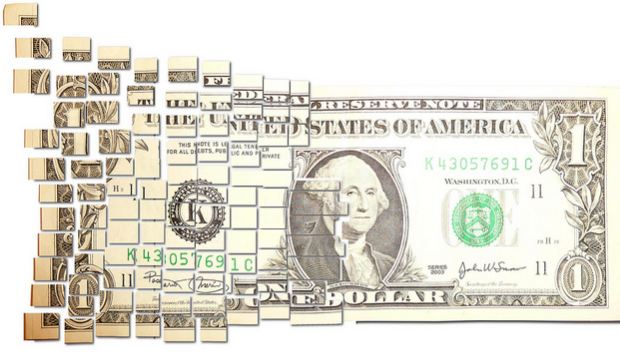Blockchain – Central Banks Banking On It As Debase Currency
Currencies / BlockChain Jan 25, 2017 - 03:14 PM GMTBy: GoldCore
 Blockchain – Central Banks Banking On Blockchain
Blockchain – Central Banks Banking On Blockchain
“The root problem with conventional currency is all the trust that’s required to make it work. The central bank must be trusted not to debase the currency, but the history of fiat currencies is full of breaches of that trust …”
Satoshi Nakamoto (Unknown person or persons who designed bitcoin and created its original reference implementation, Bitcoin Core)

Source: Photosteve101 via Flickr
Fiat currency debasement and failure is why gold has survived and thrived for thousands of years and indeed in recent years. It is why bitcoin is becoming more popular, with its growing market cap and ever-expanding ecosystem.
It is hard for central banks to dictate the value and supply of gold in the long term. Although they have tried and failed. This was seen during and after the London Gold Pool when gold prices surged from $35 to $850 in just 9 years and again in recent years when banks were found to be attempting to fix and manipulate gold prices. Manipulation frequently works in the short term but over the long term, the all powerful forces of supply and demand in the global market place will determine prices.
Similarly, it will be hard for central banks to dictate the value of bitcoin over the long term. Akin to gold, very limited supply and increasing global demand should determine prices rise in the long term.
Thus, both operate almost trust-less monetary policies and have a value in and of themselves, regardless of central bank diktats.
As it is both nature and human nature that supports gold, it is a blockchain that supports bitcoin. The bitcoin blockchain was designed so that no central bank would ever be needed to support the currency.
The bitcoin network is the bitcoin central bank, it creates new bitcoins and processes the transfer and settlement of the cryptocurrency. Monetary policy was set on day zero and its independence comes from its decentralisation.
Whilst the idea of no central bank is too much for many, you can be sure it is certainly too much for the central bankers themselves. After all, the breakthrough with bitcoin is that it is cryptography that secures it, not the force of an overarching central body. Bitcoin’s success has promoted the conversation as to how central banks can keep up, and take advantage of the technology in order to keep their monetary games going and further kicking the ‘fiat currency can’ down the road.
Central banks now want in on their own adulterated version of blockchain. It seems they have realised that they must embrace it in order to prevent their own demise.
Today, we take a brief look at why central banks are so keen to embrace the technology that was seemingly designed to render them the dodo of finance. In part two, next week we will address the concerns surrounding these apparent benefits.
Big on blockchain
15% of big banks will be using blockchain by the end of this year, according to the IMF and ‘most’ banks shortly after say the World Economic Forum (WEF). Driven by enthusiasm in the private sector, 2016 was the year the central bankers across the world woke up and began to talk about their explorations into, and the possibilities, of blockchain in the central banking system.
Dong He, who has lead research into digital currencies at the IMF, believes that the switch to digital currencies, by central banks could happen in the next five to ten years But, this depends on the speed at which the banking system moves to using the blockchain for financial transactions.
In June 2016 central bankers from 90 different countries attended a forum to discuss how the technology could be harnessed. In the same month Canada’s central bank announced that they had been experimenting with their own digital currency CAD-Coin, the UK, China and Barbados have shown similar levels of enthusiasm.
The US also book ended 2016 with positive comments on blockchain, with Federal Reserve Governor Lael Brainard stating the technology, “may represent the most significant development in many years in payments, clearing and settlement.”
Commercial banks and other financial institutions have been looking at blockchain for a while now, but for the purposes of cross-border settlements and updating legacy-laden and archaic back-office systems. Central banks appear to be interested in it all, but they are particularly focused on digital currencies and this area is not something they want to leave to chance.
Deputy governor of the People’s Bank of China, Fan Yifei, wrote for Bloomberg
“Digital currencies have shown considerable promise…[our research] suggests that the best way to take advantage of these innovations is for central banks to take the lead, both in supervising private digital currencies and in developing digital legal tender of their own.”
No more tools in the box
The financial crisis paved the way for the rise of bitcoin and a new awareness and appreciation for gold.
Both assets reawakened something that had been lost in many mindsets – we can hold assets outside of the vulnerable fractional reserve banking system and fiat monetary system, as safe havens and with reduced counter party risk. Banks everywhere were forced to acknowledge that the game would soon be up and innovation was required.
The World Economic Forum recently stated
“Central banks increasingly are under pressure to keep ‘their’ currencies attractive. They should let the general public access electronic central bank money, not just financial institutions. To do this, they should embrace the blockchain.”
Pretty much since 1971, the central banking system has played with every tool available to them. This has become glaringly obvious since the 2008 financial crisis and whilst a further major crash has been averted, the current system is in an extremely fragile position of an unprecedented nature.
The monetary tools are running out, they are blunt, old and tired.
For many central banks, this is where the attraction of a digital currency is. It is not just about catching up with the current trend to go digital but it allows the bank to look beyond exploring new regulations in regard to preventing further financial crises; a digital currency could just put a new set of conditions on the monetary system which, supporters argue, could then prevent a financial crisis.
Smart Money
Those familiar with blockchain technology will be aware that much of the fuss surrounding the technology in the last twelve months has been around smart contracts – coding the logic of a contractual clause into a transaction.
This same idea can be put into digital currencies, making way for ‘smart money’. Smart money would give a host of benefits or restrictions to the user, depending on who you are. The issuer of the currency could put various conditions into the code in order to make sure it could only be transacted if various terms had been met.
This concept can (ideologically) be run across the whole financial system – reducing the size of the shadow banking system and bringing more oversight into activities. It can also give the central bank greater control over who receives assets, at what point and whether they can keep them.
Financial Oversight
A 2015 report by the Financial Stability Board (who oversee 90% of financial system assets) estimated that the shadow banking system “accounts for $137 trillion [in 2015] and now represents about 40% of total financial system assets in 20 jurisdictions and the euro area.”
This shadow banking system, means there is very little oversight as to how credit is created and what assets belong where and on whose balance sheet. A problem which lead to the toppling of the home of cards in 2008.
This was exacerbated by the fact that it took an exceptionally long time to unwind and work out what had happened with various financial instruments. A ledger system, with real-time oversight and faster transactions may reduce this problem.
This is where the blockchain carries appeal for central bankers. Regardless of what you think of the central banking system, you must agree that their top remit is stability in the financial system. This is the same remit that Satoshi Nakamoto gave to bitcoin.
The bitcoin blockchain is a transparent system, a similar blockchain for the central banking system would provide real-time visibility of all transactions happening across the network.
This level of oversight has the potential to add 3% to a country’s economic output, according to research by the Bank of England. It could also help central banks and regulators prevent a financial crisis, rather than deal with the aftermath. By having oversight of how credit is created, they could track it and see how far an asset is lent. Perhaps even creating conditions whereby it can no longer be lent, or created, if certain conditions are not met.
The power over the banked and the unbanked
Digital currencies, compared to cash, are relatively low cost. Therefore, many central bankers support a move to a fully digital currency as they make it possible to bring more people into the system, at little cost. We have discussed our concerns about cashless societies, previously, raising concerns of how it will pave the way for negative interest rates and bail-ins to be the norm.
Kenneth Rogoff, author of the War of Cash, believes digital currencies will play a key role in the less-cash society, as he advocates
“Eventually, there will be government digital currencies that ordinary people have access to at very low cost…[but] A government digital currency could be many decades away, and there are all sorts of security and regulatory issues that have to be navigated first. That said, many central banks are already thinking about it.”
In part two we will ask what powers digital currency system will give to central banks when it comes to individual users, savers and spenders? What controls can put in place over your money, and at what point can they decide that it is no longer your money?
For many a digital currency may seem a great idea for central banks as there will be some controls over money creation. Unfortunately this isn’t a given when creating a blockchain-based currency. In fact, it could make money-printing and therefore devaluation easier, a digital currency will allow helicopter money to become a far more realistic concept.
At the moment, money printing means cash entering the financial system via the banks. It rarely reaches business and individuals. The WEF argues that the pubic should have access to a central bank issued money, if a bank account sits on a digital ledger this is possible. This smart money concept might be particularly useful to central banks who are conducting QE or just taking money printing back to basics and handing the cash straight to businesses and individuals rather than banks.
Cybersecurity
One area, we do see as a strong advantage but will be explored in more detail in part two, is cybersecurity – the blight of the banking system (see the attack on the Central Bank of Bangladesh for just one example).
In 2017 this will continue to grow as a problem. In a letter to client banks, in November 2016, SWIFT warned of cybersecurity threats “The threat is very persistent, adaptive and sophisticated – and it is here to stay.”
In a blockchain-based banking system, it would be very difficult for data to be stolen and lost forever, each time a change was made the system would update across all banks and users, therefore information would be better protected and retained.
It is worth remembering that the original blockchain – the bitcoin blockchain – is still very much in existence and in seven years it has not suffered from a single successful attack on the core protocol.
Conclusion
The jury is still very much out on whether central banks need a digital currency, or even blockchain technology. The above is a quick glance over why central banks are exploring the options over digital currencies and what it could mean for them, we look forward to exploring them more.
But, rest assured the digital currency central banking system is likely coming. The central banks and their ecosystem believe they are about to ‘uber’d’ and therefore they need to act fast.
The World Economic Forum recently wrote
“If central banks don’t join forces, they risk being cut out from intermediation and surveillance. They also run the risk that payment service providers may move to other currency areas with an institutional environment that is more appealing for buyers and sellers. Neither can be in the interest of monetary authorities, even if the technical and legal challenges of engagement are huge.”
It seems the interest of the spender, saver and business is not of much concern, we believe a far deeper look is required into the implications, and how you can protect yourselves from the inevitable digital currency revolution that is coming your way. Look out for part two.
KNOWLEDGE IS POWER
10 Important Points To Consider Before You Buy Gold
Please share our research with family, friends and colleagues who you think would benefit from being informed by it.
Gold Prices (LBMA AM)
25 Jan: USD 1,203.50, GBP 956.90 & EUR 1,119.62 per ounce
24 Jan: USD 1,213.30, GBP 972.22 & EUR 1,130.07 per ounce
23 Jan: USD 1,213.75, GBP 974.03 & EUR 1,130.12 per ounce
20 Jan: USD 1,199.10, GBP 974.87 & EUR 1,127.03 per ounce
19 Jan: USD 1,203.35, GBP 976.76 & EUR 1,129.34 per ounce
18 Jan: USD 1,212.50, GBP 984.91 & EUR 1,134.78 per ounce
17 Jan: USD 1,217.50, GBP 1,003.59 & EUR 1,141.65 per ounce
16 Jan: USD 1,202.75, GBP 997.56 & EUR 1,135.40 per ounce
13 Jan: USD 1,196.35, GBP 978.85 & EUR 1,123.25 per ounce
Silver Prices (LBMA)
24 Jan: USD 17.10, GBP 13.73 & EUR 15.92 per ounce
23 Jan: USD 17.14, GBP 13.78 & EUR 15.97 per ounce
20 Jan: USD 16.89, GBP 13.73 & EUR 15.87 per ounce
19 Jan: USD 16.95, GBP 13.75 & EUR 15.89 per ounce
18 Jan: USD 17.12, GBP 13.93 & EUR 16.01 per ounce
17 Jan: USD 17.00, GBP 13.91 & EUR 15.87 per ounce
16 Jan: USD 16.82, GBP 13.94 & EUR 15.87 per ounce
13 Jan: USD 16.76, GBP 13.76 & EUR 15.74 per ounce
Mark O'Byrne
This update can be found on the GoldCore blog here.
IRL |
UK |
IRL +353 (0)1 632 5010 |
WINNERS MoneyMate and Investor Magazine Financial Analysts 2006
Disclaimer: The information in this document has been obtained from sources, which we believe to be reliable. We cannot guarantee its accuracy or completeness. It does not constitute a solicitation for the purchase or sale of any investment. Any person acting on the information contained in this document does so at their own risk. Recommendations in this document may not be suitable for all investors. Individual circumstances should be considered before a decision to invest is taken. Investors should note the following: Past experience is not necessarily a guide to future performance. The value of investments may fall or rise against investors' interests. Income levels from investments may fluctuate. Changes in exchange rates may have an adverse effect on the value of, or income from, investments denominated in foreign currencies. GoldCore Limited, trading as GoldCore is a Multi-Agency Intermediary regulated by the Irish Financial Regulator.
GoldCore is committed to complying with the requirements of the Data Protection Act. This means that in the provision of our services, appropriate personal information is processed and kept securely. It also means that we will never sell your details to a third party. The information you provide will remain confidential and may be used for the provision of related services. Such information may be disclosed in confidence to agents or service providers, regulatory bodies and group companies. You have the right to ask for a copy of certain information held by us in our records in return for payment of a small fee. You also have the right to require us to correct any inaccuracies in your information. The details you are being asked to supply may be used to provide you with information about other products and services either from GoldCore or other group companies or to provide services which any member of the group has arranged for you with a third party. If you do not wish to receive such contact, please write to the Marketing Manager GoldCore, 63 Fitzwilliam Square, Dublin 2 marking the envelope 'data protection'
GoldCore Archive |
© 2005-2022 http://www.MarketOracle.co.uk - The Market Oracle is a FREE Daily Financial Markets Analysis & Forecasting online publication.





